Progressive Trends in Hybrid Material-Based Chemiresistive Sensors for Nitroaromatic Compounds
Abstract
1. Introduction
1.1. Background of the Hybrid Materials
- (i)
- Composites: matrix and micron-level dispersion constituting the material mixture.
- (ii)
- Nanocomposites: combination of comparable types of materials at the sub-micron scale.
- (iii)
- Hybrids: a sub-micron-scale combination of several materials.
- (iv)
- Nanohybrids: composite, nanocomposite, hybrid, and non-hybrid materials that have been combined at the atomic or molecular level via chemical bonding.
1.2. History of Chemiresistive Sensors
1.3. Broadening of Nitroaromatic Compounds
2. Prerequisites for Chemiresistive Sensors
3. Progress on Chemiresistive Sensors for Nitroaromatic Compounds
3.1. Pesticide Sensors
3.2. Explosive Sensor
3.3. Persistent Organic Pollutant (POP) Sensors
3.4. Polyaromatic Hydrocarbon Sensor
3.5. Miscellaneous Sensing
4. Challenges and Conclusions
Author Contributions
Funding
Institutional Review Board Statement
Informed Consent Statement
Data Availability Statement
Acknowledgments
Conflicts of Interest
References
- Saveleva, M.S.; Eftekhari, K.; Abalymov, A.; Douglas, T.E.L.; Volodkin, D.; Parakhonskiy, B.V.; Skirtach, A.G. Hierarchy of hybrid materials-the place of inorganics-in-organics in it, their composition and applications. Front. Chem. 2019, 7, 179. [Google Scholar] [CrossRef]
- Rejab, M.R.B.M.; Hamdan, M.H.B.M.; Quanjin, M.; Siregar, J.P.; Bachtiar, D.; Muchlis, Y. Historical Development of Hybrid Materials. Encycl. Renew. Sustain. Mater. 2020, 4, 445–455. [Google Scholar] [CrossRef]
- Faustini, M.; Nicole, L.; Ruiz-Hitzky, E.; Sanchez, C. History of Organic–Inorganic Hybrid Materials: Prehistory, Art, Science, and Advanced Applications. Adv. Funct. Mater. 2018, 28, 1704158. [Google Scholar] [CrossRef]
- Zhu, Y.-P.; Yuan, Z.-Y. History and Classification of Non-Siliceous Hybrid Materials; Springer: Berlin/Heidelberg, Germany, 2015; ISBN 978-3-662-45634-7. [Google Scholar]
- Radulović, J. Hybrid filament-wound materials: Tensile characteristics of (aramide fiber/glass fiber)-epoxy resins composite and (carbon fibers/glass fiber)-epoxy resins composites. Sci. Tech. Rev. 2020, 70, 36–46. [Google Scholar] [CrossRef]
- Nanko, M. Definitions and Categories of Hybrid Materials. Adv. Mater. Process. Technol. 2009, 11, 1–8. [Google Scholar]
- Das, P.P.; Chaudhary, V.; Kumar Singh, R.; Singh, D.; Aditya Bachchan, A. Advancement in hybrid materials, its applications and future challenges: A review. Mater. Today Proc. 2021, 47, 3794–3801. [Google Scholar] [CrossRef]
- Peng, Y.; Zhao, M.; Chen, B.; Zhang, Z.; Huang, Y.; Dai, F.; Lai, Z.; Cui, X.; Tan, C.; Zhang, H. Hybridization of MOFs and COFs: A New Strategy for Construction of MOF@COF Core–Shell Hybrid Materials. Adv. Mater. 2018, 30, 1705454. [Google Scholar] [CrossRef]
- Campbell, M.G.; Sheberla, D.; Liu, S.F.; Swager, T.M.; Dincă, M. Cu3(hexaiminotriphenylene)2: An Electrically Conductive 2D Metal—Organic Framework for Chemiresistive Sensing. Angew. Chemie Int. Ed. 2015, 54, 4349–4352. [Google Scholar] [CrossRef]
- Singh, T.; Rarotra, S.; Kumar, P.; Sharma, R.; Sridharan, V.; Sonne, C. Current perspectives on the environmental applications using conductive metal–organic frameworks (CMOFs). J. Porous Mater. 2022. [Google Scholar] [CrossRef]
- Kolleboyina, J.; DMello, M.E.; Kesavan, K.; Schneemann, A.; Otyepka, M.; Kment, S.; Narayana, C.; Kalidindi, S.B.; Varma, R.S.; Zboril, R.; et al. A multifunctional covalently linked graphene–MOF hybrid as an effective chemiresistive gas sensor. J. Mater. Chem. A 2021, 9, 17434–17441. [Google Scholar] [CrossRef]
- Chen, S.; Yuan, B.; Liu, G.; Zhang, D. Electrochemical Sensors Based on Covalent Organic Frameworks: A Critical Review. Front. Chem. 2020, 8, 1082. [Google Scholar] [CrossRef]
- Andre, R.S.; Facure, M.H.M.; Schneider, R.; Migliorini, F.L.; dos Santos, D.M.; Mercante, L.A.; Correa, D.S. Sensing Materials: Nanofibers Produced by Electrospinning and Solution Blow Spinning. In Encyclopedia of Sensors and Biosensors, 1st ed.; Roger, N., Ed.; Elsevier: Amsterdam, The Netherlands, 2022; Volume 2, pp. 521–541. ISBN 9780128225493. [Google Scholar]
- Neri, G. First Fifty Years of Chemoresistive Gas Sensors. Chemosensors. 2015, 3, 1–20. [Google Scholar] [CrossRef]
- Wilson, D.M.; Hoyt, S.; Janata, J.; Booksh, K.; Obando, L. Chemical sensors for portable, handheld field instruments. IEEE Sens. J. 2001, 1, 256–274. [Google Scholar] [CrossRef]
- Pandey, S. Highly sensitive and selective chemiresistor gas/vapor sensors based on polyaniline nanocomposite: A comprehensive review. J. Sci. Adv. Mater. Devices 2016, 1, 431–453. [Google Scholar] [CrossRef]
- Abdel-Karim, R.; Reda, Y.; Abdel-Fattah, A. Review—Nanostructured Materials-Based Nanosensors. J. Electrochem. Soc. 2020, 167, 037554. [Google Scholar] [CrossRef]
- Nishiwaki, N. A Walk through Recent Nitro Chemistry Advances. Molecules 2020, 25, 3680. [Google Scholar] [CrossRef]
- Ju, K.-S.; Parales, R.E. Nitroaromatic Compounds, from Synthesis to Biodegradation. Microbiol. Mol. Biol. Rev. 2010, 74, 250. [Google Scholar] [CrossRef]
- Tiwari, J.; Tarale, P.; Sivanesan, S.; Bafana, A. Environmental persistence, hazard, and mitigation challenges of nitroaromatic compounds. Environ. Sci. Pollut. Res. 2019, 26, 28650–28667. [Google Scholar] [CrossRef]
- Lee, P.R. Explosives Development and Fundamentals of Explosives Technology. In Explosive Effects and Applications; Springer: Berlin/Heidelberg, Germany, 1998; pp. 23–45. [Google Scholar] [CrossRef]
- Young, R.A. Dinitrotoluene. In Encyclopedia of Toxicology, 3rd ed.; Elsevier: Amsterdam, The Netherlands, 2014; pp. 179–182. [Google Scholar] [CrossRef]
- Booth, G. Nitro Compounds, Aromatic. In Ullmann’s Encyclopedia of Industrial Chemistry; Wiley-VCH: Weinheim, Germany, 2000. [Google Scholar] [CrossRef]
- Pichtel, J. Distribution and fate of military explosives and propellants in soil: A review. Appl. Environ. Soil Sci. 2012, 2012, 617236. [Google Scholar] [CrossRef]
- Graham, T. The Explosive History of Nitrogen. ChemMatters 2003, 8–10. Available online: https://highschoolenergy.acs.org/content/hsef/en/how-do-we-use-energy/history-of-nitrogen/_jcr_content/articleContent/columnsbootstrap/column1/acscontainer_0/containerPar/download/file.res/Explosive_History_Nitrogen.pdf (accessed on 25 October 2022).
- Zhang, L.; Kang, Z.; Xin, X.; Sun, D. Metal–organic frameworks based luminescent materials for nitroaromatics sensing. Cryst. Eng. Comm. 2015, 18, 193–206. [Google Scholar] [CrossRef]
- Khanyile, N. Advances in Nanostructured Polyamide-Based Chemical Sensors. J. Nanomater. 2022, 2022, 5543283. [Google Scholar] [CrossRef]
- Koo, W.-T.; Jang, J.-S.; Kim, I.-D. Metal-Organic Frameworks for Chemiresistive Sensors. Chem 2019, 5, 1938–1963. [Google Scholar] [CrossRef]
- Pal, S.; Yu, S.S.; Kung, C.W. Group 4 Metal-Based Metal—Organic Frameworks for Chemical Sensors. Chemosensors 2021, 9, 306. [Google Scholar] [CrossRef]
- DMello, M.E.; Sundaram, N.G.; Singh, A.; Singh, A.K.; Kalidindi, S.B. An amine functionalized zirconium metal–organic framework as an effective chemiresistive sensor for acidic gases. Chem. Commun. 2019, 55, 349–352. [Google Scholar] [CrossRef] [PubMed]
- Mitri, F.; De Iacovo, A.; De Santis, S.; Giansante, C.; Sotgiu, G.; Colace, L. Chemiresistive Device for the Detection of Nitroaromatic Explosives Based on Colloidal PbS Quantum Dots. ACS Appl. Electron. Mater. 2021, 3, 3234–3239. [Google Scholar] [CrossRef]
- Guo, L.; Yang, Z.; Li, Y.; Zu, B.; Dou, X. Sensitive, real-time and anti-interfering detection of nitro-explosive vapors realized by ZnO/rGO core/shell micro-Schottky junction. Sens. Actuators B Chem. 2017, 239, 286–294. [Google Scholar] [CrossRef]
- Li, Y.; Zhou, W.; Zu, B.; Dou, X. Qualitative Detection Toward Military and Improvised Explosive Vapors by a Facile TiO2 Nanosheet-Based Chemiresistive Sensor Array. Front. Chem. 2020, 8, 29. [Google Scholar] [CrossRef]
- Ghoorchian, A.; Alizadeh, N. Chemiresistor gas sensor based on sulfonated dye-doped modified conducting polypyrrole film for high sensitive detection of 2,4,6-trinitrotoluene in air. Sens. Actuators B Chem. 2018, 255, 826–835. [Google Scholar] [CrossRef]
- Zhang, W.; Wu, Z.; Hu, J.; Cao, Y.; Guo, J.; Long, M.; Duan, H.; Jia, D. Flexible chemiresistive sensor of polyaniline coated filter paper prepared by spraying for fast and non-contact detection of nitroaromatic explosives. Sens. Actuators B Chem. 2020, 304, 127233. [Google Scholar] [CrossRef]
- Qu, J.; Ge, Y.; Zu, B.; Li, Y.; Dou, X. Transition-Metal-Doped p-Type ZnO Nanoparticle-Based Sensory Array for Instant Discrimination of Explosive Vapors. Small 2016, 12, 1369–1377. [Google Scholar] [CrossRef] [PubMed]
- Wei, L.; Lu, D.; Wang, J.; Wei, H.; Zhao, J.; Geng, H.; Zhang, Y. Highly sensitive detection of trinitrotoluene in water by chemiresistive sensor based on noncovalently amino functionalized single-walled carbon nanotube. Sens. Actuators B Chem. 2014, 190, 529–534. [Google Scholar] [CrossRef]
- Zhang, Y.; Xu, M.; Bunes, B.R.; Wu, N.; Gross, D.E.; Moore, J.S.; Zang, L. Oligomer-coated carbon nanotube chemiresistive sensors for selective detection of nitroaromatic explosives. ACS Appl. Mater. Interfaces 2015, 7, 7471–7475. [Google Scholar] [CrossRef] [PubMed]
- Hao, Y.; Sun, G.; Fan, T.; Sun, X.; Liu, Y.; Zhang, N.; Zhao, L.; Zhong, R.; Peng, Y. Prediction on the mutagenicity of nitroaromatic compounds using quantum chemistry descriptors based QSAR and machine learning derived classification methods. Ecotoxicol. Environ. Saf. 2019, 186, 109822. [Google Scholar] [CrossRef] [PubMed]
- Zhang, F.; Wang, Y.; Chu, T.; Wang, Z.; Li, W.; Yang, Y. A facile fabrication of electrodeposited luminescent MOF thin films for selective and recyclable sensing of nitroaromatic explosives. Analyst 2016, 141, 4502–4510. [Google Scholar] [CrossRef]
- Kumar, P.; Kim, K.H.; Lee, J.; Shang, J.; Khazi, M.I.; Kumar, N.; Lisak, G. Metal-organic framework for sorptive/catalytic removal and sensing applications against nitroaromatic compounds. J. Ind. Eng. Chem. 2020, 84, 87–95. [Google Scholar] [CrossRef]
- Xu, N.; Zhang, Q.; Zhang, G. A carbazole-functionalized metal–organic framework for efficient detection of antibiotics, pesticides and nitroaromatic compounds. Dalt. Trans. 2019, 48, 2683–2691. [Google Scholar] [CrossRef]
- Zhang, X.; Chen, S.; Jin, S.; Zhang, Y.; Chen, X.; Zhang, Z.; Shu, Q. Naphthalene based lab-on-a-molecule for fluorimetric and colorimetric sensing of F− and CN− and nitroaromatic explosives. Sens. Actuators B Chem. 2017, 242, 994–998. [Google Scholar] [CrossRef]
- Herrera-Chacon, A.; Gonzalez-Calabuig, A.; Del Valle, M. Dummy Molecularly Imprinted Polymers Using DNP as a Template Molecule for Explosive Sensing and Nitroaromatic Compound Discrimination. Chemosensors 2021, 9, 255. [Google Scholar] [CrossRef]
- Janfaza, S.; Banan Nojavani, M.; Nikkhah, M.; Alizadeh, T.; Esfandiar, A.; Ganjali, M.R. A selective chemiresistive sensor for the cancer-related volatile organic compound hexanal by using molecularly imprinted polymers and multiwalled carbon nanotubes. Microchim. Acta 2019, 186, 137. [Google Scholar] [CrossRef]
- Gaikwad, S.; Bodkhe, G.; Deshmukh, M.; Patil, H.; Rushi, A.; Shirsat, M.D.; Koinkar, P.; Kim, Y.H.; Mulchandani, A. Chemiresistive sensor based on polythiophene-modified single-walled carbon nanotubes for detection of NO2. Mod. Phys. Lett. B 2015, 29, 1540046. [Google Scholar] [CrossRef]
- Nagarajan, V.; Chandiramouli, R. Investigation on probing explosive nitroaromatic compound vapors using graphyne nanosheet: A first-principle study. Struct. Chem. 2019, 30, 657–667. [Google Scholar] [CrossRef]
- Rattan, S.; Singhal, P.; Verma, A.L. Synthesis of PEDOT:PSS (poly(3,4-ethylenedioxythiophene))/poly(4-styrene sulfonate))/ ngps (nanographitic platelets) nanocomposites as chemiresistive sensors for detection of nitroaromatics. Polym. Eng. Sci. 2013, 53, 2045–2052. [Google Scholar] [CrossRef]
- Rawtani, D.; Khatri, N.; Tyagi, S.; Pandey, G. Nanotechnology-based recent approaches for sensing and remediation of pesticides. J. Environ. Manage. 2018, 206, 749–762. [Google Scholar] [CrossRef] [PubMed]
- Kovida; Sharma, V.; Koner, A.L. Rapid on-site and naked-eye detection of common nitro pesticides with ionic liquids. Analyst 2020, 145, 4335–4340. [Google Scholar] [CrossRef] [PubMed]
- Bhuvaneswari, R.; Nagarajan, V.; Chandiramouli, R. Novel ε-arsenene nanosheets for sensing toxic malathion and parathion—A first-principles approach. Comput. Theor. Chem. 2020, 1190, 112995. [Google Scholar] [CrossRef]
- Ramnani, P.; Saucedo, N.M.; Mulchandani, A. Carbon nanomaterial-based electrochemical biosensors for label-free sensing of environmental pollutants. Chemosphere 2016, 143, 85–98. [Google Scholar] [CrossRef]
- Huang, X.L.; Liu, L.; Gao, M.L.; Han, Z.B. A luminescent metal–organic framework for highly selective sensing of nitrobenzene and aniline. RSC Adv. 2016, 6, 87945–87949. [Google Scholar] [CrossRef]
- Furton, K.G.; Myers, L.J. The scientific foundation and efficacy of the use of canines as chemical detectors for explosives. Talanta 2001, 54, 487–500. [Google Scholar] [CrossRef]
- Gares, K.L.; Hufziger, K.T.; Bykov, S.V.; Asher, S.A. Review of explosive detection methodologies and the emergence of standoff deep UV resonance Raman. J. Raman Spectrosc. 2016, 47, 124–141. [Google Scholar] [CrossRef]
- Zhang, J.; Fahrenthold, E.P. Graphene nanoribbons as flexible docks for chemiresistive sensing of gas phase explosives. Nanoscale 2020, 12, 10730–10736. [Google Scholar] [CrossRef] [PubMed]
- Meng, F.L.; Guo, Z.; Huang, X.J. Graphene-based hybrids for chemiresistive gas sensors. TrAC Trends Anal. Chem. 2015, 68, 37–47. [Google Scholar] [CrossRef]
- Zhang, J.; Fahrenthold, E.P. Graphene-Based Sensing of Gas-Phase Explosives. ACS Appl. Nano Mater. 2019, 2, 1445–1456. [Google Scholar] [CrossRef]
- Ge, Y.; Wei, Z.; Li, Y.; Qu, J.; Zu, B.; Dou, X. Highly sensitive and rapid chemiresistive sensor towards trace nitro-explosive vapors based on oxygen vacancy-rich and defective crystallized In-doped ZnO. Sensors Actuators B Chem. 2017, 244, 983–991. [Google Scholar] [CrossRef]
- Koudehi, M.F.; Pourmortazavi, S.M. Polyvinyl Alcohol/Polypyrrole/Molecularly Imprinted Polymer Nanocomposite as Highly Selective Chemiresistor Sensor for 2,4-DNT Vapor Recognition. Electroanalysis 2018, 30, 2302–2310. [Google Scholar] [CrossRef]
- Alizadeh, T.; Hamedsoltani, L. Graphene/graphite/molecularly imprinted polymer nanocomposite as the highly selective gas sensor for nitrobenzene vapor recognition. J. Environ. Chem. Eng. 2014, 2, 1514–1526. [Google Scholar] [CrossRef]
- Tang, R.; Shi, Y.; Hou, Z.; Wei, L. Carbon Nanotube-Based Chemiresistive Sensors. Sensors 2017, 17, 882. [Google Scholar] [CrossRef]
- Kodavanti, P.R.S.; Royland, J.E.; Sambasiva Rao, K.R.S. Toxicology of Persistent Organic Pollutants. Ref. Modul. Biomed. Sci. 2014. [Google Scholar] [CrossRef]
- Wagner, M.; Andrew Lin, K.Y.; Oh, W.D.; Lisak, G. Metal-organic frameworks for pesticidal persistent organic pollutants detection and adsorption—A mini review. J. Hazard. Mater. 2021, 413, 125325. [Google Scholar] [CrossRef]
- Albacete, P.; López-Moreno, A.; Mena-Hernando, S.; Platero-Prats, A.E.; Pérez, E.M.; Zamora, F. Chemical sensing of water contaminants by a colloid of a fluorescent imine-linked covalent organic framework. Chem. Commun. 2019, 55, 1382–1385. [Google Scholar] [CrossRef]
- Guselnikova, O.; Postnikov, P.; Elashnikov, R.; Miliutina, E.; Svorcik, V.; Lyutakov, O. Metal-organic framework (MOF-5) coated SERS active gold gratings: A platform for the selective detection of organic contaminants in soil. Anal. Chim. Acta 2019, 1068, 70–79. [Google Scholar] [CrossRef] [PubMed]
- Bandowe, B.A.M.; Meusel, H. Nitrated polycyclic aromatic hydrocarbons (nitro-PAHs) in the environment—A review. Sci. Total Environ. 2017, 581–582, 237–257. [Google Scholar] [CrossRef] [PubMed]
- Øvrevik, J.; Arlt, V.M.; Øya, E.; Nagy, E.; Mollerup, S.; Phillips, D.H.; Låg, M.; Holme, J.A. Differential effects of nitro-PAHs and amino-PAHs on cytokine and chemokine responses in human bronchial epithelial BEAS-2B cells. Toxicol. Appl. Pharmacol. 2010, 242, 270–280. [Google Scholar] [CrossRef] [PubMed]
- Toledo, M.; Lanças, F.M.; Carrilho, E. Solid-phase extraction of nitro-PAH from aquatic samples and its separation by reverse-phase capillary liquid chromatography. J. Braz. Chem. Soc. 2007, 18, 1004–1010. [Google Scholar] [CrossRef]
- Xia, Q.; Yin, J.J.; Zhao, Y.; Wu, Y.S.; Wang, Y.Q.; Ma, L.; Chen, S.; Sun, X.; Fu, P.P.; Yu, H. UVA Photoirradiation of Nitro-Polycyclic Aromatic Hydrocarbons—Induction of Reactive Oxygen Species and Formation of Lipid Peroxides †. Int. J. Environ. Res. Public Health 2013, 10, 1062–1084. [Google Scholar] [CrossRef]
- Falciglia, P.P.; De Guidi, G.; Catalfo, A.; Vagliasindi, F.G.A. Remediation of soils contaminated with PAHs and nitro-PAHs using microwave irradiation. Chem. Eng. J. 2016, 296, 162–172. [Google Scholar] [CrossRef]
- Yang, L.; Zhang, X.; Xing, W.; Zhou, Q.; Zhang, L.; Wu, Q.; Zhou, Z.; Chen, R.; Toriba, A.; Hayakawa, K.; et al. Yearly variation in characteristics and health risk of polycyclic aromatic hydrocarbons and nitro-PAHs in urban shanghai from 2010–2018. J. Environ. Sci. 2021, 99, 72–79. [Google Scholar] [CrossRef]
- Shu, J.H.; Wikle, H.C.; Chin, B.A. Passive chemiresistor sensor based on iron (II) phthalocyanine thin films for monitoring of nitrogen dioxide. Sensors Actuators B Chem. 2010, 148, 498–503. [Google Scholar] [CrossRef]
- Shaik, M.; Rao, V.K.; Gupta, M.; Murthy, K.S.R.C.; Jain, R. Chemiresistive gas sensor for the sensitive detection of nitrogen dioxide based on nitrogen doped graphene nanosheets. RSC Adv. 2015, 6, 1527–1534. [Google Scholar] [CrossRef]
- Supraja, P.; Tripathy, S.; Singh, R.; Singh, V.; Chaudhury, G.; Singh, S.G. Towards point-of-care diagnosis of Alzheimer’s disease: Multi-analyte based portable chemiresistive platform for simultaneous detection of β-amyloid (1–40) and (1–42) in plasma. Biosens. Bioelectron. 2021, 186, 113294. [Google Scholar] [CrossRef]
- Wang, T.; Huang, D.; Yang, Z.; Xu, S.; He, G.; Li, X.; Hu, N.; Yin, G.; He, D.; Zhang, L. A Review on Graphene-Based Gas/Vapor Sensors with Unique Properties and Potential Applications. Nano-Micro Lett. 2015, 8, 95–119. [Google Scholar] [CrossRef] [PubMed]
- Lee, J.H. Gas sensors using hierarchical and hollow oxide nanostructures: Overview. Sensors Actuators B Chem. 2009, 140, 319–336. [Google Scholar] [CrossRef]
- Swager, T.M. Sensor Technologies Empowered by Materials and Molecular Innovations. Angew. Chemie Int. Ed. 2018, 57, 4248–4257. [Google Scholar] [CrossRef] [PubMed]
- Chen, E.-X.; Yang, H.; Zhang, J. Zeolitic Imidazolate Framework as Formaldehyde Gas Sensor. Inorg. Chem. 2014, 53, 5411–5413. [Google Scholar] [CrossRef] [PubMed]
- Sun, L.; Campbell, M.G.; Dincă, M. Electrically Conductive Porous Metal–Organic Frameworks. Angew. Chemie Int. Ed. 2016, 55, 3566–3579. [Google Scholar] [CrossRef]

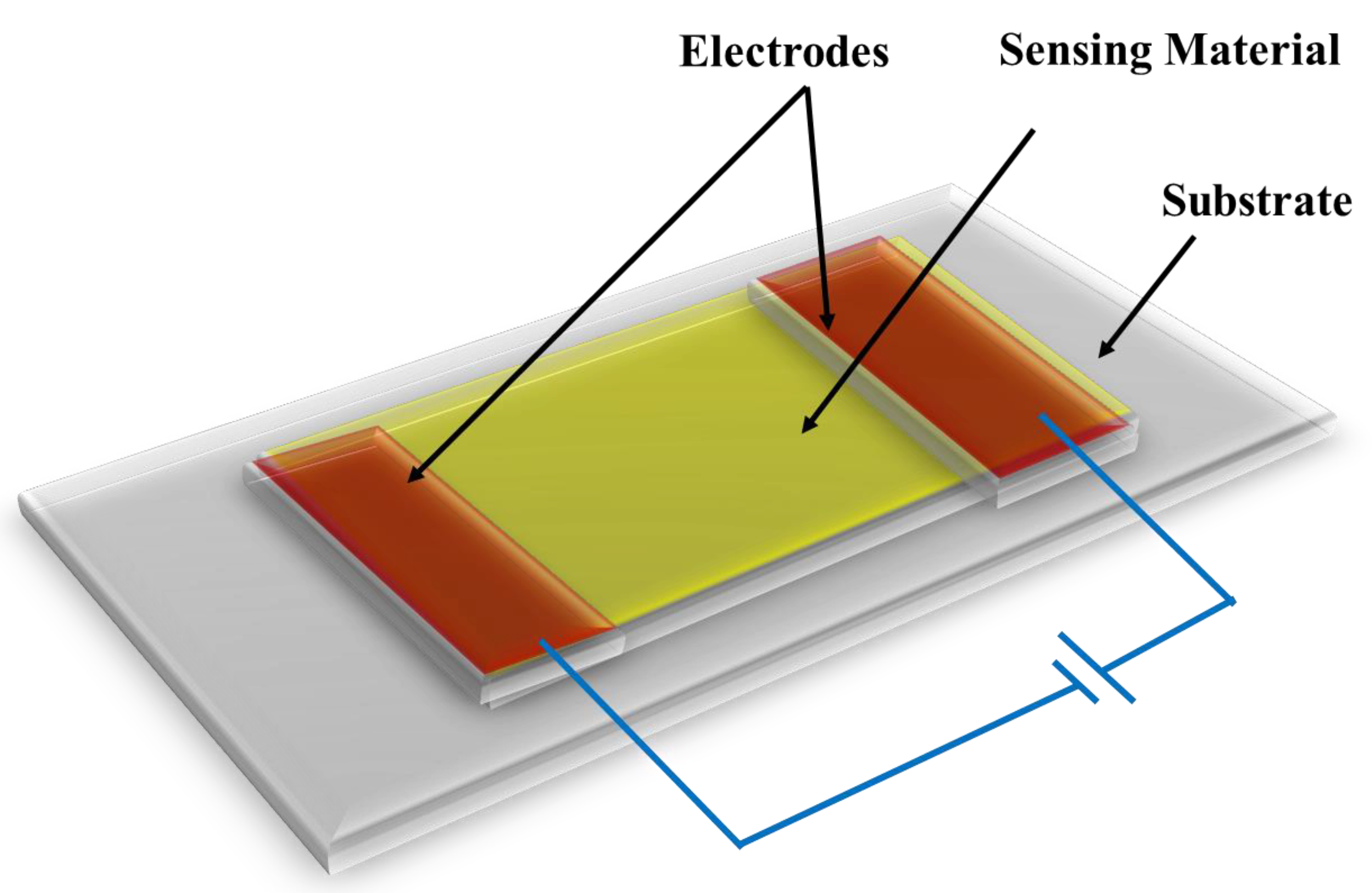


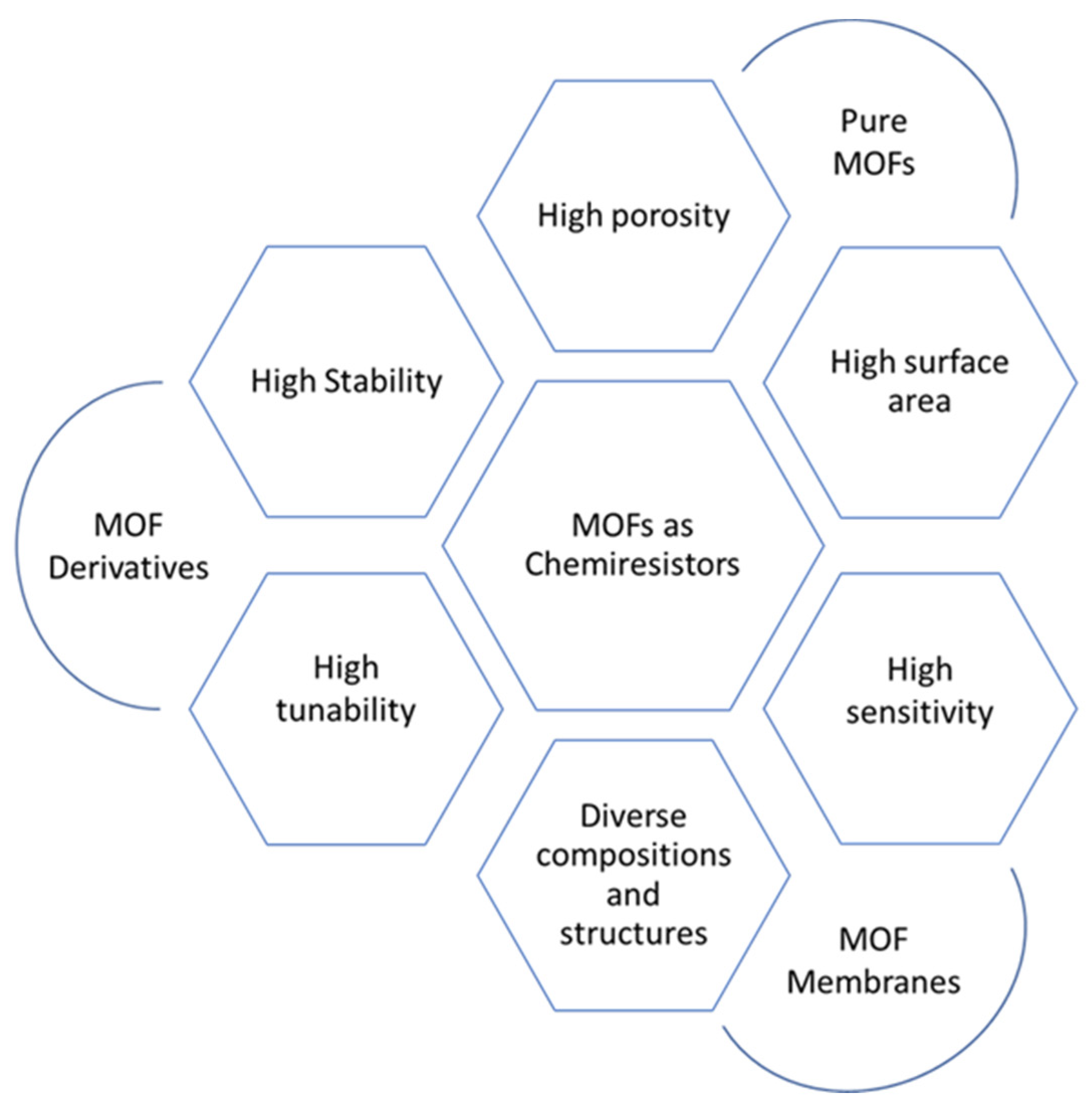
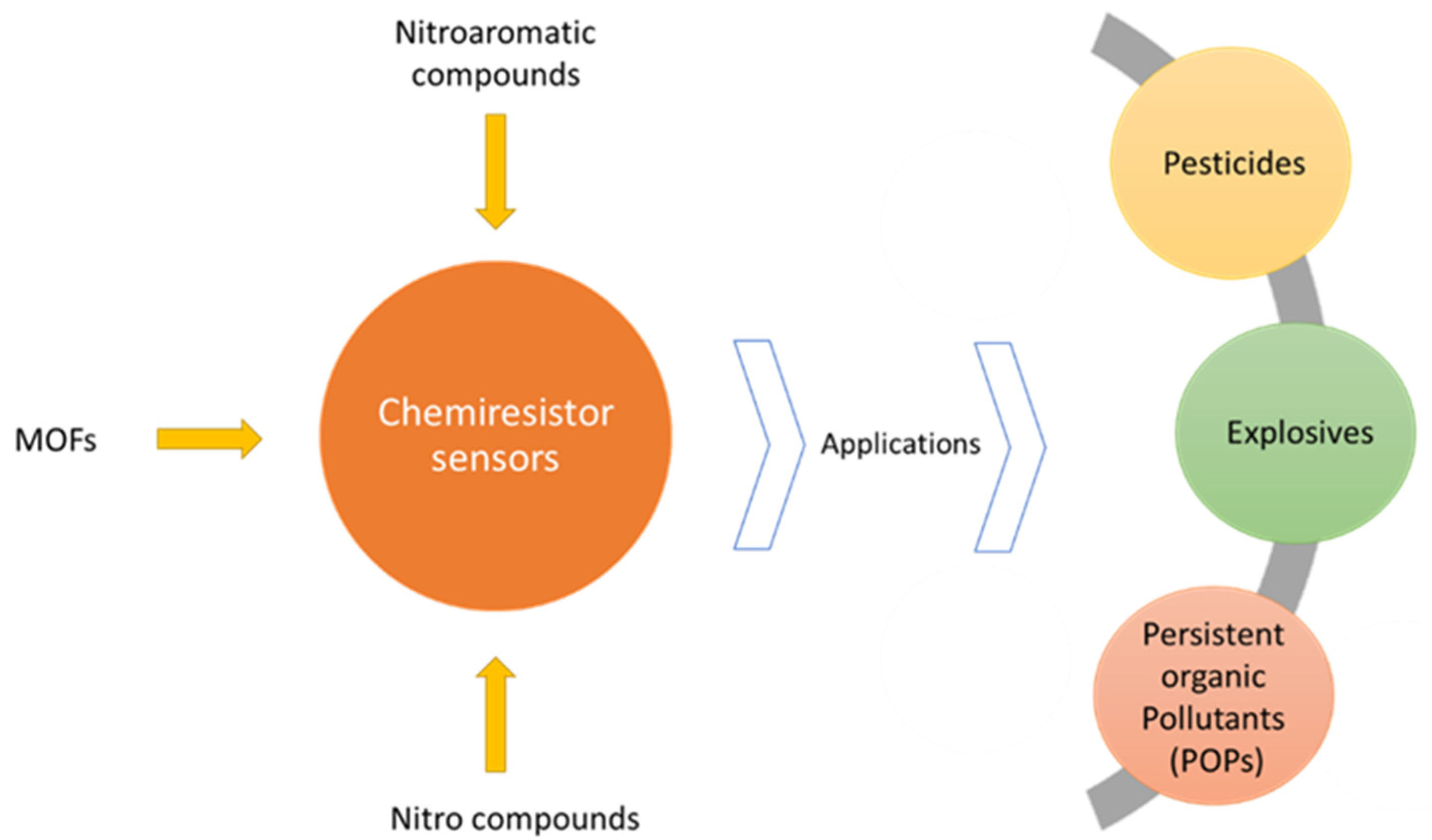
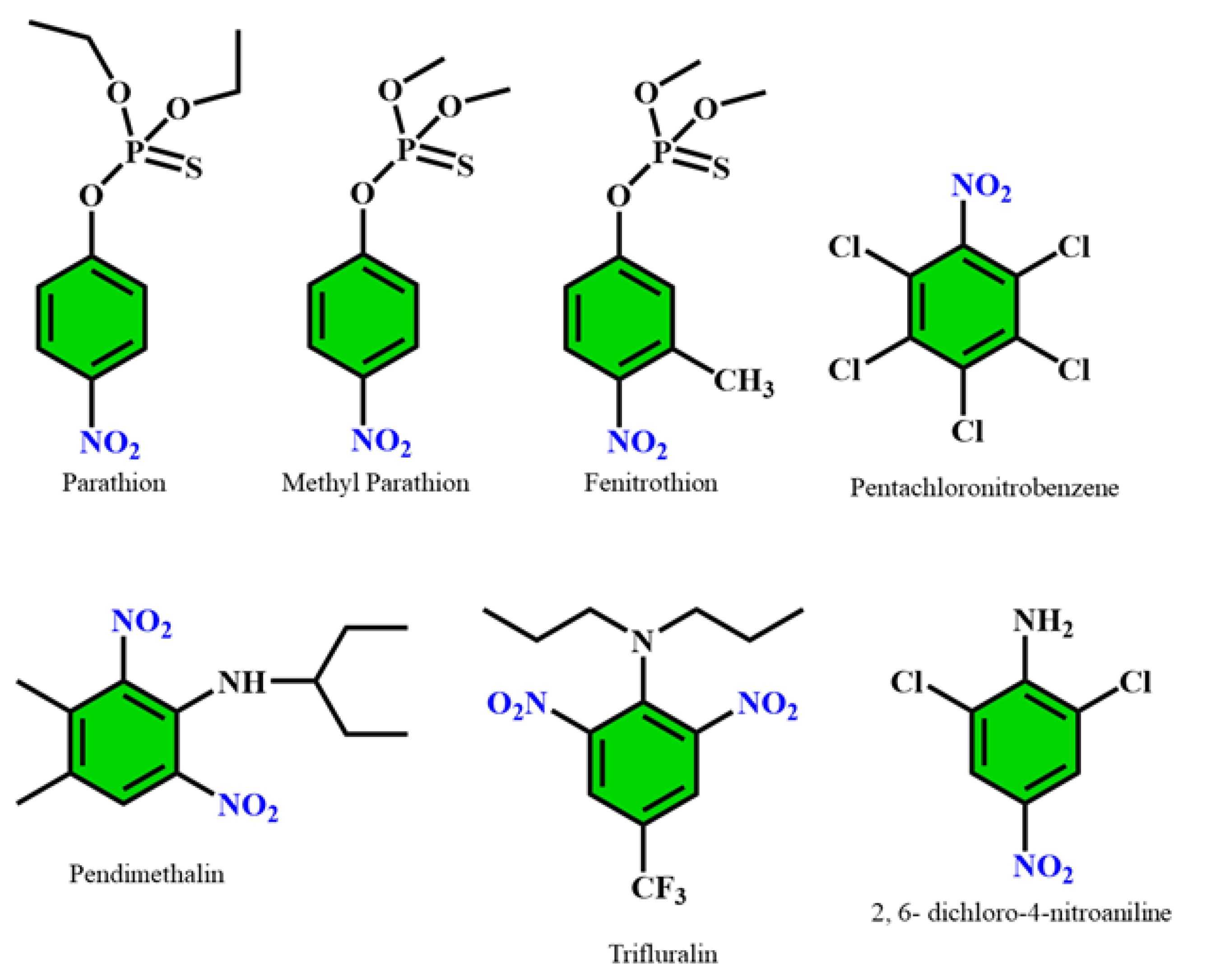


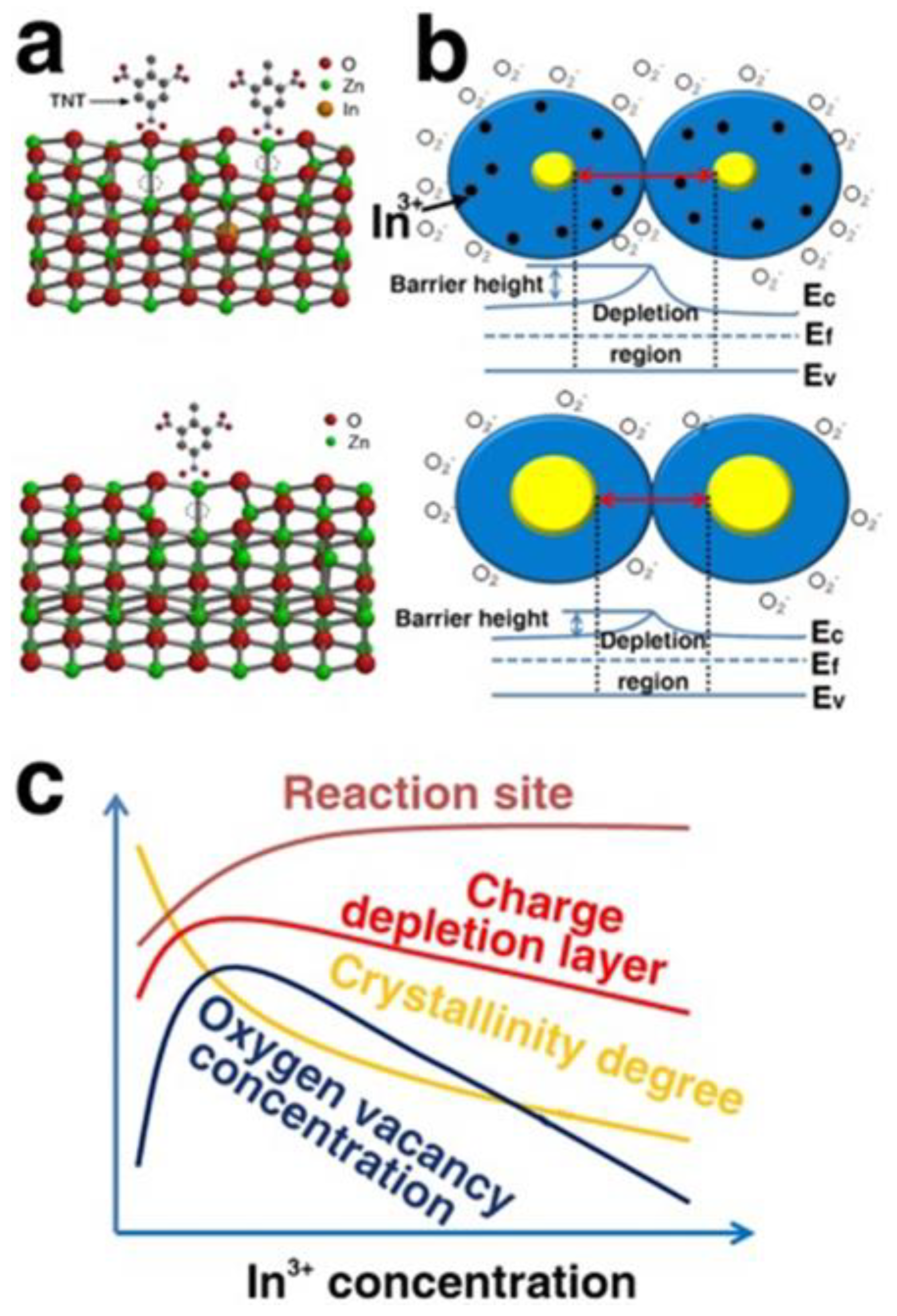
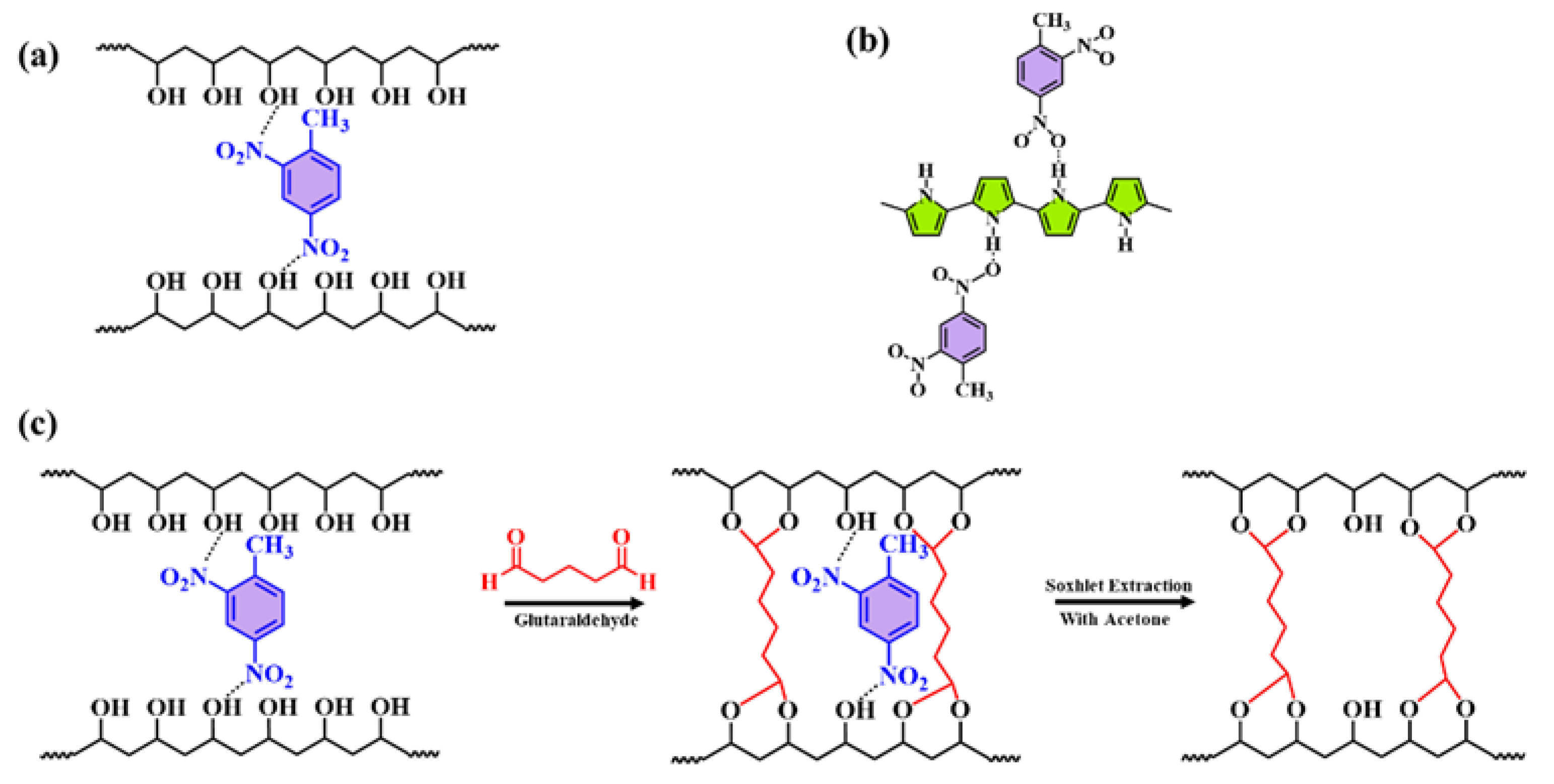
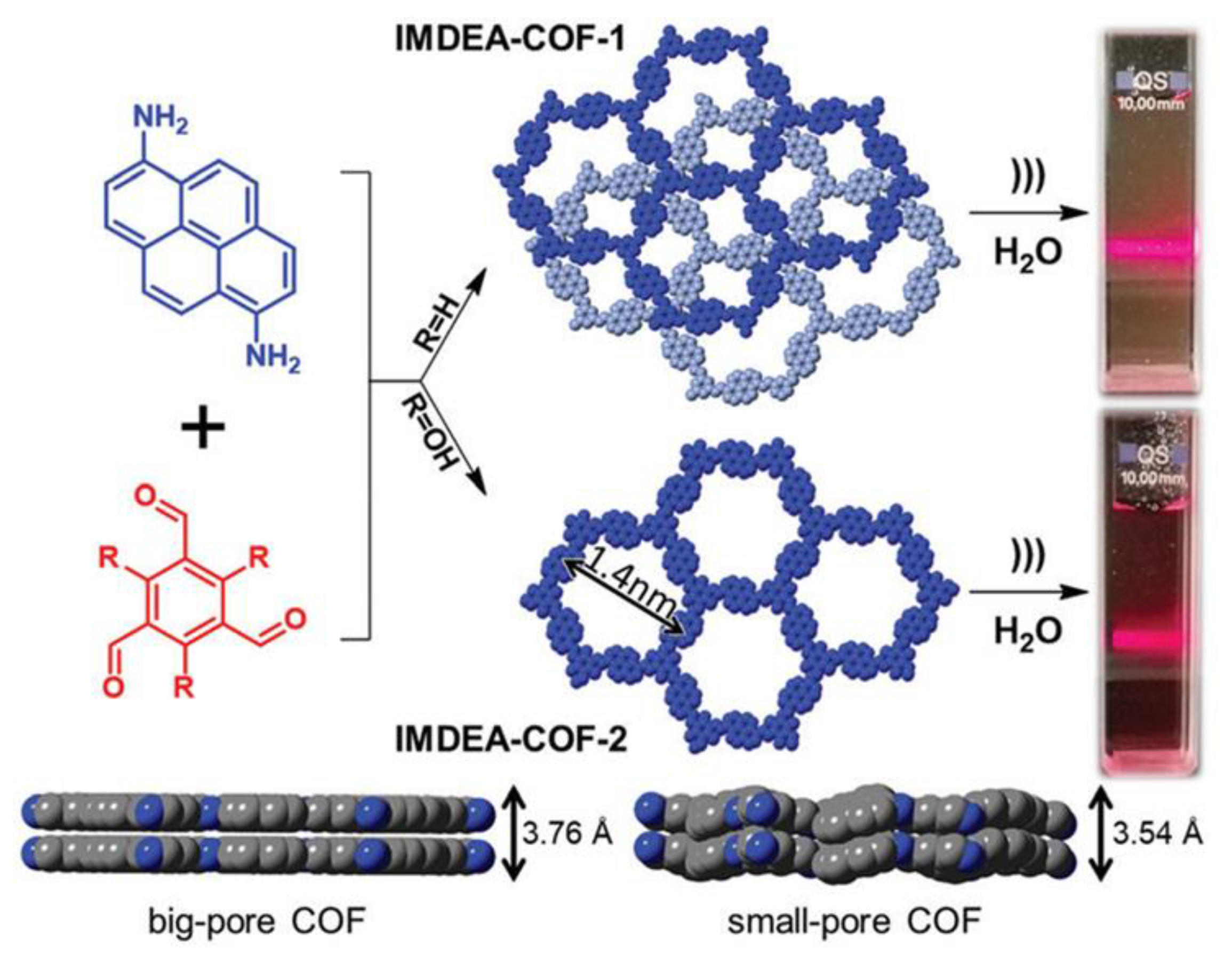
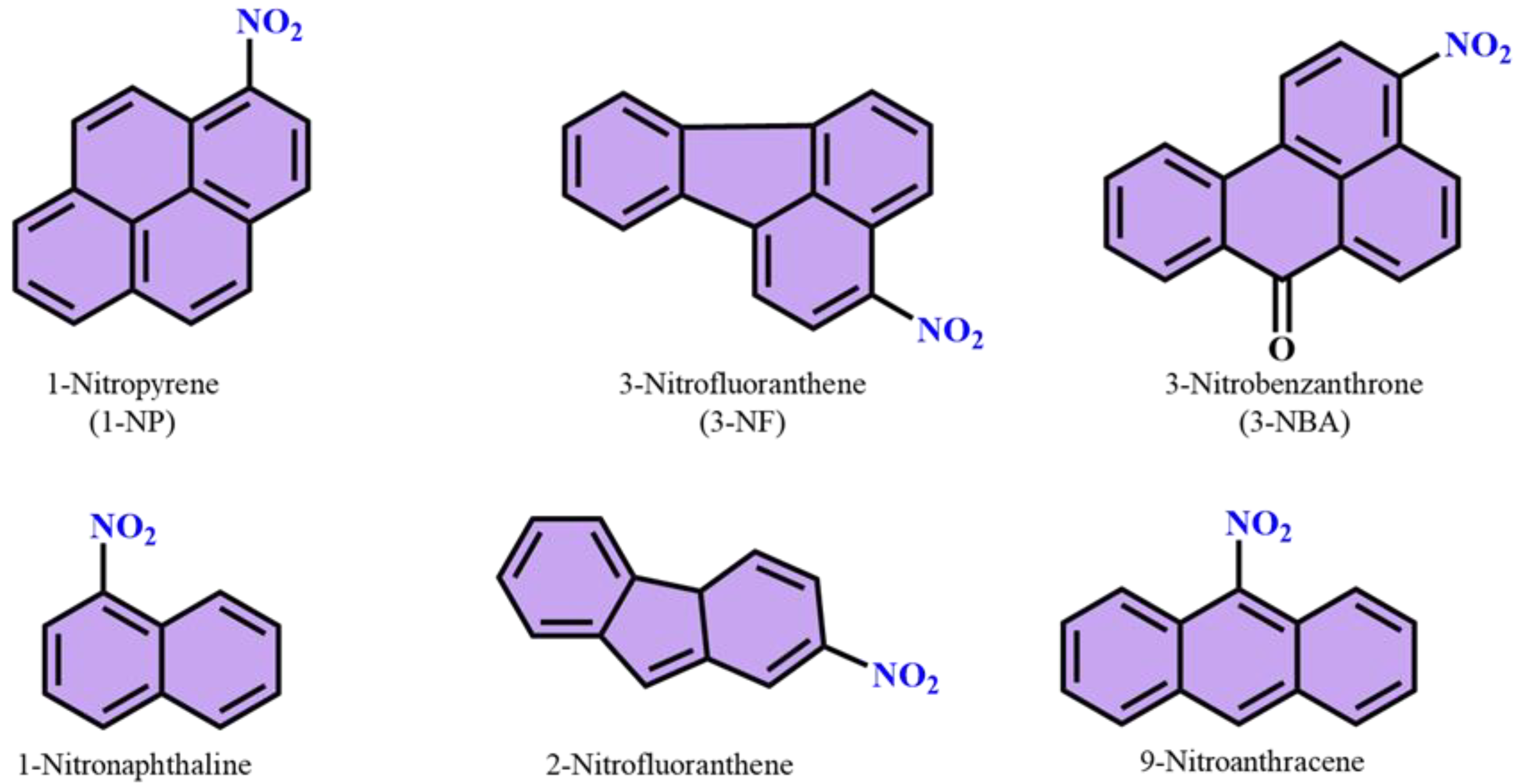
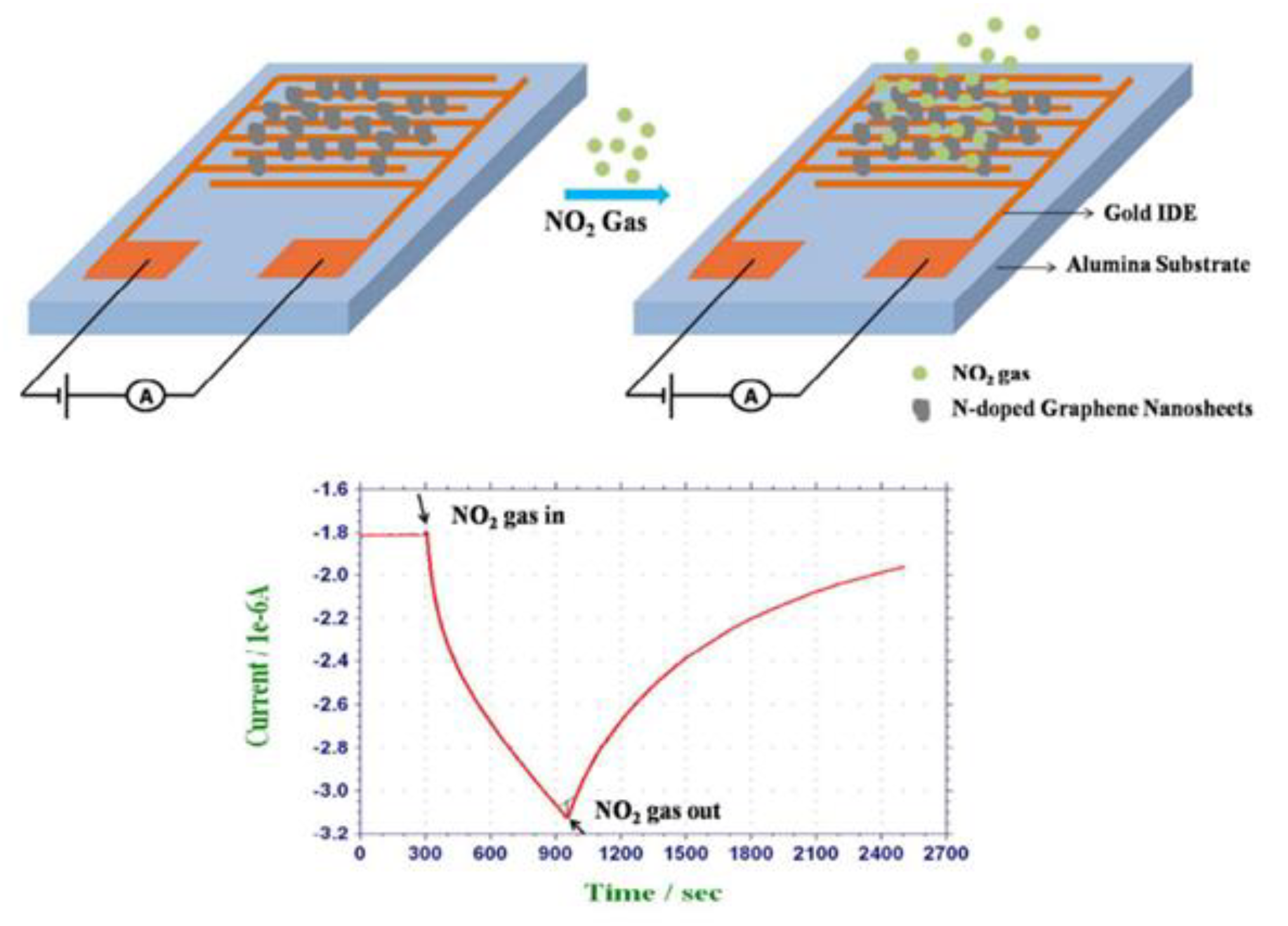

| Type of Sensor | Analyte | Material Used in Sensing | Detection Limit | Analyte Concentration | Response | Reference |
|---|---|---|---|---|---|---|
| Quantum dots | NB | PbS quantum dots | 65 ppb–16 ppm | - | - | [31] |
| Schottky junction-based | DNT | Core-shell ZnO/reduced graphene oxide (rGO) | 411 ppb | - | - | [32] |
| TNT | Core-shell ZnO/reduced graphene oxide (rGO) | 9 ppb | - | - | [32] | |
| RDX | Core-shell ZnO/reduced graphene oxide (rGO) | 4.9 ppt | - | - | [32] | |
| Nanosheets | DNT | TiO2 nanosheets | - | 180 ppb | 65.5% | [33] |
| TNT | TiO2 nanosheets | - | 9 ppb | 115.6% | [33] | |
| RDX | TiO2 nanosheets | - | 4.9 ppt | 40.0% | [33] | |
| PNT | TiO2 nanosheets | - | 647 ppb | 830.0% | [33] | |
| PA | TiO2 nanosheets | - | 097 ppb | 115.0% | [33] | |
| Organic polymer film | TNT | PPy-BCGnBA | 0.2 ppb | - | - | [34] |
| Fibers | TNT | flower-like PANI fibers | 0.094 ppb | - | 8.1 s | [35] |
| PA | flower-like PANI fibers | 0.029 ppb | - | - | [35] | |
| Transition-metal doped nanoparticle | TNT | Ni-ZnO | - | 9.1 ppb | 45.5% | [36] |
| DNT | Fe-ZnO | - | 411 ppb | 38.9% | [36] | |
| RDX | Ni-ZnO | - | 4.9 ppt | 45.5% | [36] | |
| PNT | Ni-ZnO | - | 647 ppb | 22.9% | [36] | |
| PA | Fe-ZnO | - | 0.97 ppb | 36.1% | [36] | |
| SWCNT | TNT | PMA-SWCNT network | - | 10 ppt | - | [37] |
| Carbazole oligomer CNT composite materials | NT (4-nitrotoluene) | Tg-Car/CNT | 95 ppb | - | - | [38] |
Publisher’s Note: MDPI stays neutral with regard to jurisdictional claims in published maps and institutional affiliations. |
© 2022 by the authors. Licensee MDPI, Basel, Switzerland. This article is an open access article distributed under the terms and conditions of the Creative Commons Attribution (CC BY) license (https://creativecommons.org/licenses/by/4.0/).
Share and Cite
Awasthi, G.; Sharma, R.; Sundarrajan, S.; Ramakrishna, S.; Kumar, P. Progressive Trends in Hybrid Material-Based Chemiresistive Sensors for Nitroaromatic Compounds. Polymers 2022, 14, 4643. https://doi.org/10.3390/polym14214643
Awasthi G, Sharma R, Sundarrajan S, Ramakrishna S, Kumar P. Progressive Trends in Hybrid Material-Based Chemiresistive Sensors for Nitroaromatic Compounds. Polymers. 2022; 14(21):4643. https://doi.org/10.3390/polym14214643
Chicago/Turabian StyleAwasthi, Gaurav, Ritika Sharma, Subramanian Sundarrajan, Seeram Ramakrishna, and Pawan Kumar. 2022. "Progressive Trends in Hybrid Material-Based Chemiresistive Sensors for Nitroaromatic Compounds" Polymers 14, no. 21: 4643. https://doi.org/10.3390/polym14214643
APA StyleAwasthi, G., Sharma, R., Sundarrajan, S., Ramakrishna, S., & Kumar, P. (2022). Progressive Trends in Hybrid Material-Based Chemiresistive Sensors for Nitroaromatic Compounds. Polymers, 14(21), 4643. https://doi.org/10.3390/polym14214643









